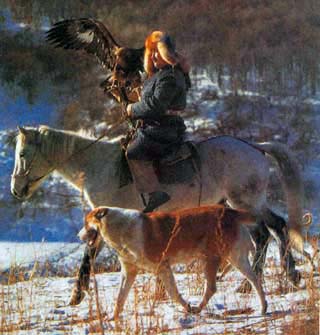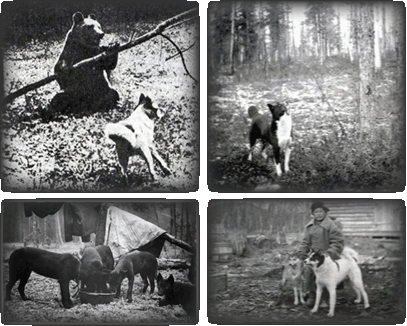To provide you with a glimpse into the life of the Karelian Bear Dog as it once was, we present information and history that was gathered based on our own research as well as translations of Russian publications that was shared with us by Vladimir Beregovoy, a zoologist now residing in the United States who traveled throughout much of Russia during his work for the Institute of Biology, Uralian Branch of Academy of Sciences of the USSR. We are grateful to Vladimir and the zoologists, wildlife biologists, hunters, archeologists and ethnographers who have published valuable information that is archived or still circulating in Russia today.
Far back in time, well before the Russian Empire--and long before dogs became pedigreed--dogs of similar "type" (morphology and temperament) existed in northeastern Europe. Across Komi country (the birthplace of the native dogs that the Finns later chose to preserve through selective breeding and named the Karelian Bear Dog), dogs lived for millennia (thousands of years) off leash in villages, without fences. The dogs wouldn't generally travel far from home on their own, so physical isolation allowed local types of dogs to remain somewhat distinct.
For many of the native peoples who inhabited the very cold taiga forest zone just south of the Arctic, survival was challenging. Hunting with dogs made their existence possible. Hunting provided meat for their families, and pelts could be sold or traded to obtain other goods like guns, gun powder, lead, tobacco, tea and flour. Pelts were so valuable that Russians called them "fur-gold". That made the best hunting dogs themselves an economically valuable commodity. Traveling by sleds pulled by reindeer or sled dogs, the native peoples would make their way to trading posts and provincial fairs to buy and sell furs, tea, tobacco, reindeer... and, yes, dogs. On the way back home from a trading event, which often included plenty of festivities and drinking, dogs were even sometimes left behind, where they lived out their lives mingling freely with the local type dogs. Vladimir Beregovoy -- who himself traveled N. Ural and the Yamal Peninsula as late as the 1960s -- tells us that large groups of dogs (up to 50) would greet him barking and wagging their tails as he entered a village.

Above, one gets a sense of the strong bond between hunter and hunting dog from this picture of a Kazakh hunter in Kazakhstan (which existed as the Kazakh SSR republic in the Soviet Union prior to full independence) with his primitive dog, a Tazi/Tobet mix, and golden eagle, both of which assisted in the hunt. He is wearing a fur hat made out of fox pelts known as a "malakhai." The Tobet is large fearless guardian dog (of sheep, cattle, and home). The Tazi (Saluki in Arabic) is considered a primitive hunting hound, perhaps the oldest known breed of domesticated dog, appearing on the Egyptian tombs of 2,100 BC. The Tazi were so esteemed that they were often mummified like the bodies of the Pharaohs (rulers of the Egyptian kingdom in the pre-Christian, pre-Islamic period) themselves. As a side note, Kazakh couture (fashion design) strutted its stuff at the Palace Hotel in Manhattan in November 2006 for a crowd that included Kazakh diplomats there to celebrate their independence day, where designer Nina Lazaridi showed updated Central Asian classics that included the malakhai. |
 |
The Karelians' ancestors
In East Siberia, the Laikas used by the natives of Tungus looked identical to the Karelian Bear Dogs or Russo-European Laikas of today. These aboriginal (native) Siberian dogs hunted in the same way as today's hunting Laikas, tracking on the ground, sniffing air, listening and barking under trees at birds, squirrels, and sables. Perhaps most importantly, they were bear hunting dogs, as good at hunting as any other in Finland or central Russia. (Photographs above were provided by Vladimir Beregovoy; lower left was photographed by L.V.Girshfeld, 1926; others photographed by N.P. Naumov, 1926-1927).
For perspective into the vastness of the area inhabited by the aboriginal dogs that pre-dated the dogs we refer to today as Karelian Bear Dogs, we need to look at a map of Russia.
What do wolves and Karelian Bear Dogs have in common? |
|


